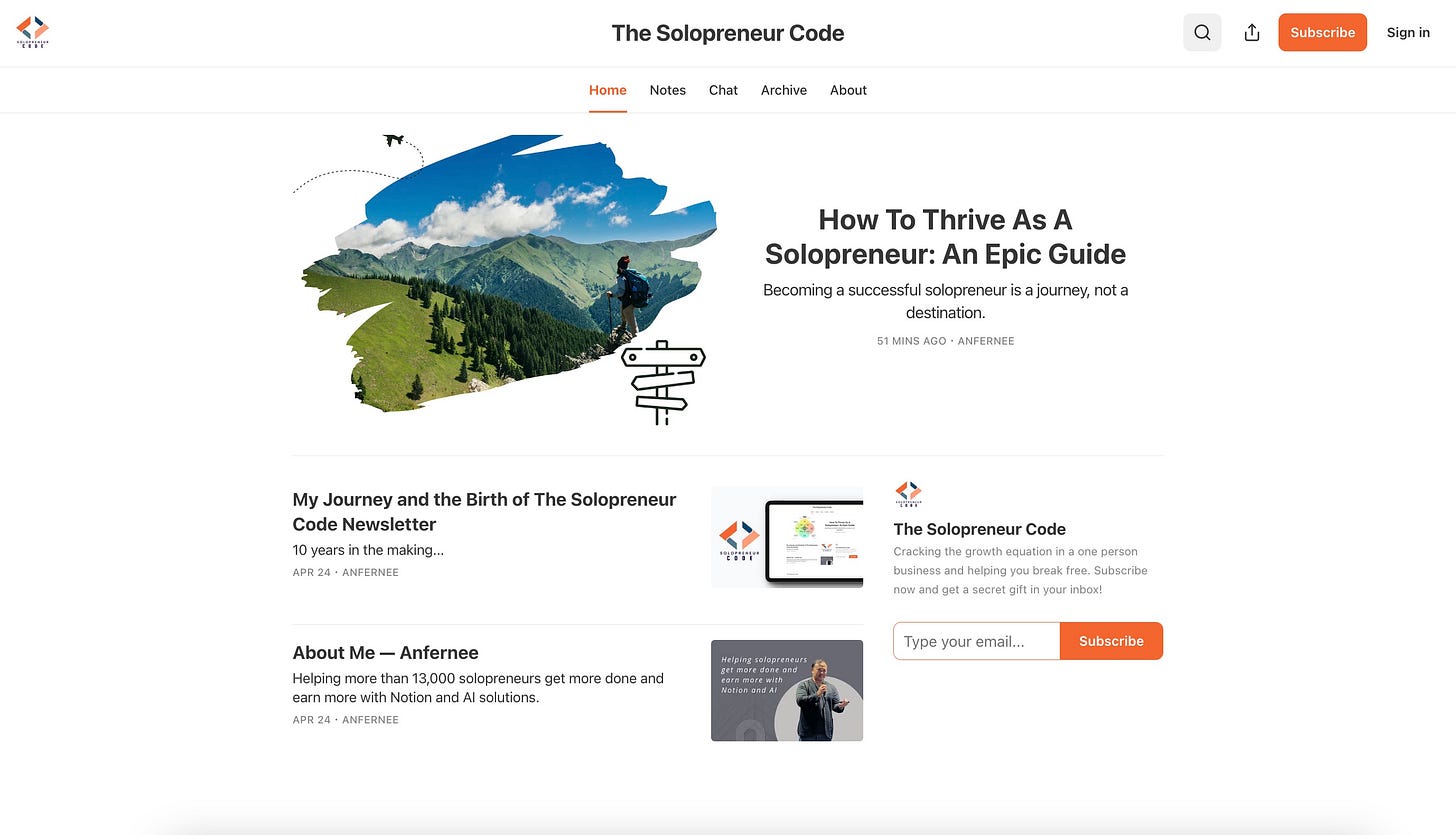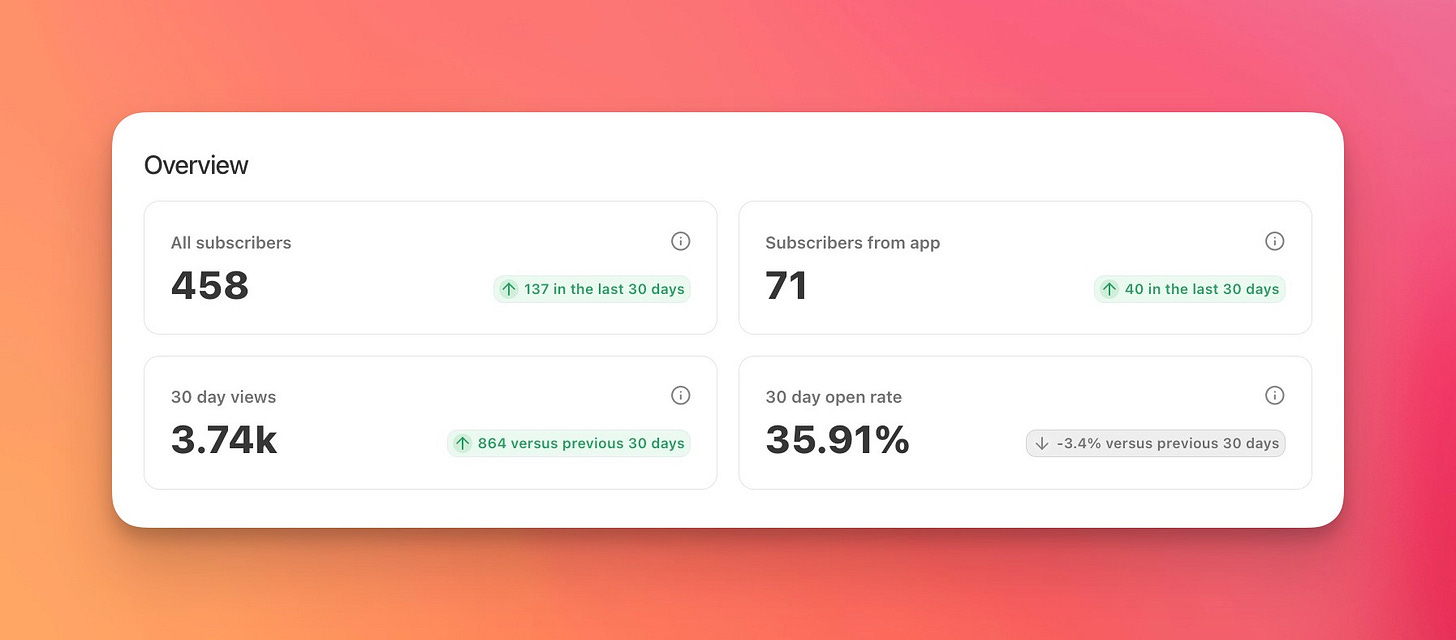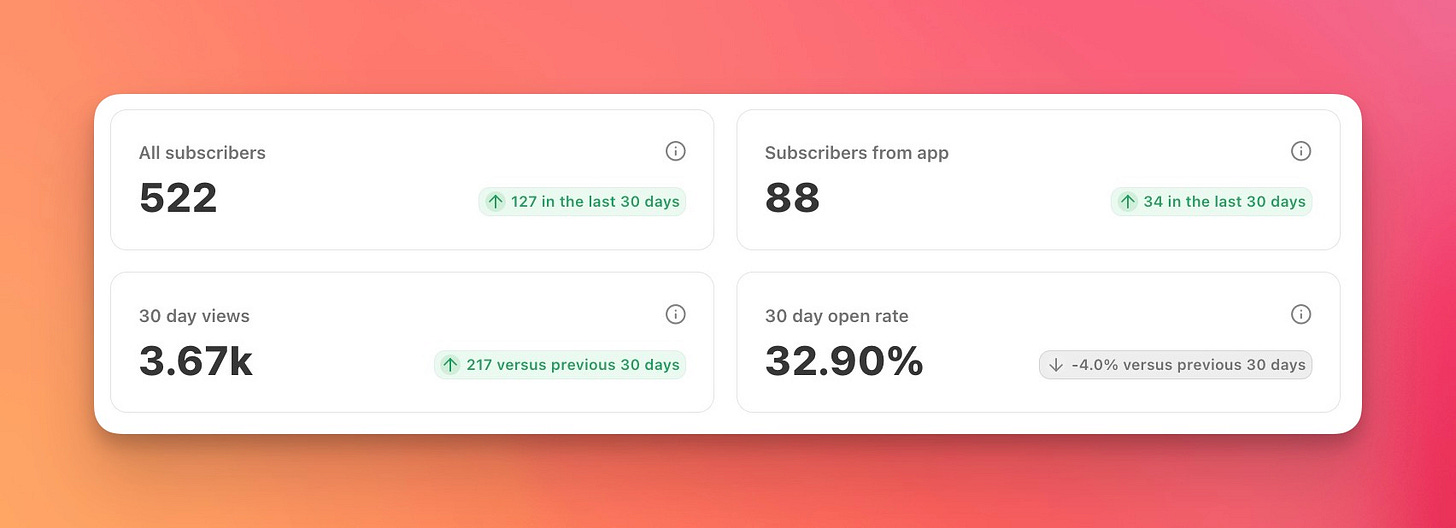The First 100 Days of Solopreneur Code
37 Posts, 400+ Notes, 524 Subscribers, 791 Followers and 10 Lessons
Solopreneur Code was soft launched on 24 April 2024. Today, 2 August 2024, I am celebrating Solopreneur Code’s 100th day.
So let’s look back at the 100 days and evaluate the progress of Solopreneur Code so far.
The tradition of evaluating the first 100 days in a new role or endeavour originates from Franklin D. Roosevelt's presidency in the United States. During his first 100 days, he implemented significant changes to combat the Great Depression.
This period is now often used as a benchmark to assess the early impact and effectiveness of leaders, projects, or initiatives.
The Journey So Far
My first posts. How many of your first post are ‘Coming Soon’? Haha!
My first Note on the launch day.
Within the next 2 days, I posted this:
And this…
My landing page on 26 April 2024
I crossed my first 100 subscribers after just 14 days!
I’ve reached another milestone with 258 amazing subscribers and and 291 followers in ONLY ONE MONTH on Substack!
Started a new series - 📚 Solopreneurs Should Be Ultralearners
Taken 16 Jul 2024
Taken 1 Aug 2024, with 522 subscribers and 789 followers. Nice!
And 524 Subscribers, 791 Followers when publishing this post.
My 100 Days Lessons Learned On Managing A Newsletter
Start Before You Are Ready
PS: Because you will never be ready
I was never ready to start this newsletter; I had experimented with a Medium but delayed the newsletter for years, wishing I had just begun. I built it up to be much bigger in my head, thinking it needed to be perfect.
But the truth is, nobody cares when you start, and you have no subscribers initially, so nobody is judging you anyway. Don't worry about being "good"; that will come over time as your efforts compound. Just start!
Collect Ideas Strategically
Do you have a system for collecting ideas? If not, you need one as soon as possible. My writing only became easier once I had a system in place. Whenever I have an insight or think of something, I quickly jot it down in my Notion.
The biggest lie we tell ourselves is,
'I don’t need to write this down because I will remember it.'
- Kevin Kelly
When it comes to writing time, having all these curation of ideas makes getting started a breeze. If you can’t generate enough ideas, you may need more inputs, such as reading, podcasts, and YouTube, or more reflection, such as long walks, journaling, and meditation. The secret is to always get started…
Everything Comes Together After You Start
We often hesitate to start because we don't feel creative at the moment, mistakenly believing that creativity requires a sudden burst of inspiration.
However, creativity actually emerges from action.
There have been countless times when I didn't feel like writing, but by forcing myself to start, I found myself in a creative flow within ten minutes, and before I knew it, two hours had flown by.
As Billy Oppenheimer aptly puts it, "You become creative by creating."
Subscriber Quality > Quantity
When building your email list, it’s tempting to focus on rapid growth. But here’s a game-changer: prioritise the quality of your subscribers. A business with an email list of 1,000 engaged contacts can achieve far better results than one with 10,000 disinterested subscribers.
Quality subscribers are those who fit neatly into your target audience and engage deeply with your content. Instead of chasing numbers, aim for genuine engagement and relevance.
If you are using lead magnets, make sure your lead magnet aligns with your core offer and content, so that the people who subscribes to your newsletter are your target audience.
An Email List Is Your Ultimate Trust Weapon
You might wonder why someone would subscribe to a newsletter when they can read the same content on a blog or LinkedIn, or simply just Google search.
The answer is trust.
Subscribers give you their email addresses because they value your insights and want to stay updated. This is a powerful trust-building step. By consistently sharing valuable content, you nurture this trust, demonstrate your expertise, and address your audience’s pain points.
People do business with those they trust.
Your Newsletter as an Educational Channel
Think of your newsletter as an educational tool rather than a direct sales channel. The primary goal is to educate and provide value to your subscribers.
Share insights, address their needs, and build trust.
Business opportunities will naturally follow when you've established yourself as a valuable resource.
Integrate Your Newsletter with Your Broader Strategy
Your newsletter shouldn't exist in isolation. Connect it with other platforms like your website, blog, social media, and webinars. Cross-share content to create a cohesive narrative and expand your reach.
For instance, sharing your newsletter on LinkedIn can drive significant subscriber growth. An integrated approach ensures your audience receives consistent and valuable information across various channels.
Consistency and Setting Expectations Are Critical
Sending your newsletter at regular intervals and maintaining consistent sections builds habits with your subscribers. They come to expect your content at certain times and in familiar formats.
I send out my newsletters twice a week - Thursday and Sunday. On my Sunday post, I always include a tiny section where I share with my subscribers interesting Substacks I found for the week. This is effective as it boast engagement and I get to promote other interesting articles as well.
This consistency is crucial for becoming a trusted resource. Establish a routine, refine your design, and deliver on your promises to foster a loyal subscriber base.
Stay Top of Mind with Prospects
An email list is a cost-effective way to stay top of mind with prospects. Regularly providing valuable content ensures that when they are ready to make a purchase, they think of you and visit your site first.
Nurturing contacts is a long-term strategy, not a quick win. By consistently delivering value, you build a reliable pipeline of potential clients.
Leverage Email List KPIs for Insights
Track key performance indicators like open rates, click-through rates, and conversion rates to gauge your newsletter’s effectiveness.
These metrics provide insights into your content’s impact and highlight areas for improvement.
Combining this data with other marketing metrics can enhance your overall strategy significantly.
Conclusion
The journey of a solopreneur is one of continuous evolution, marked by both triumphs and setbacks. It’s a path that requires perpetual learning, adaptability, and an unwavering commitment to creating value. As I reflect on my first 100 days, it’s clear that success isn’t merely about hitting milestones or gaining numbers; it’s about the relationships built, the lessons learned, and the growth experienced along the way.
The magic of solopreneurship lies in the intersection of passion and persistence. It’s in those moments of doubt and uncertainty where true innovation and creativity are born.
Ultimately, the solopreneur journey is not a sprint but a marathon. It’s about showing up consistently, fostering trust, and always striving to provide genuine value. The insights gained and the connections made along the way are the true rewards of this solopreneurial odyssey.
Here’s to embracing the journey, cherishing the growth, and looking forward to the endless possibilities that lie ahead.
“Live as if you were to die tomorrow. Learn as if you were to live forever.”\
― Mahatma Gandhi
Cracking the growth equation in a one person business,
Anfernee
Like this post? Consider doing these 2 things:
"The Solopreneur Code" is targeted towards solo entrepreneurs, providing insights, tips, and strategies for success in running a business independently, share with your community if you think this is helpful for them.
Have a question? Comment below!













Great post. How do you track the newsletter KPIs? Do you rely solely on the inbuilt dashboard in Substack or do you export the data into a spreadsheet or other tool?
Doing well so far. Keep the momentum